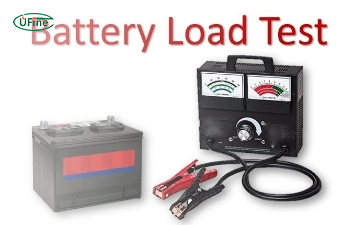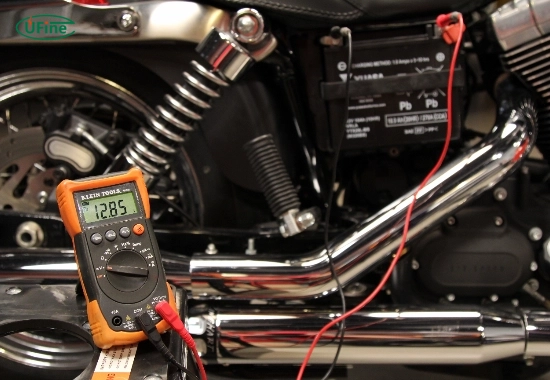
- Part 1. Why is checking a motorcycle battery essential?
- Part 2. What tools do you need to check a motorcycle battery?
- Part 3. How do you safely access your motorcycle battery?
- Part 4. How do you check motorcycle battery voltage with a multimeter?
- Part 5. How to perform a load test on a motorcycle battery?
- Part 6. How do you check for battery corrosion and clean it?
- Part 7. How to check if your motorcycle battery is charging correctly?
- Part 8. When should you replace your motorcycle battery?
- Part 9. How do you extend the life of your motorcycle battery?
- Part 10. FAQs about checking a motorcycle battery
A motorcycle battery is essential for starting your bike and powering its electronics. If your motorcycle won’t start or the lights are dim, your battery might be the problem. But how do you check a motorcycle battery properly?
In this guide, we’ll walk you through the steps to inspect and test your motorcycle battery to ensure it’s in good condition. Whether you’re a beginner or an experienced rider, these steps will help you diagnose battery problems quickly.
Part 1. Why is checking a motorcycle battery essential?
A healthy battery ensures that your motorcycle starts smoothly and runs efficiently. If a battery is weak or faulty, it can leave you stranded. Here’s why checking your battery regularly is crucial:
- Prevents unexpected breakdowns: A weak battery can fail at times.
- Extends battery life: Regular checks help you maintain it properly.
- Saves money: Replacing a battery before it completely dies can be more cost-effective.
- Ensures safety: A failing battery can cause electrical issues in your motorcycle.
Now, let’s dive into how to check your motorcycle battery step by step.
Part 2. What tools do you need to check a motorcycle battery?
Before you start testing your motorcycle battery, gather the following tools:
- Multimeter: Measures voltage and helps diagnose battery health.
- Battery charger: Useful if your battery needs recharging.
- Gloves and safety glasses: Protect yourself from battery acid.
- Wrench or screwdriver: The battery needs to be removed from its compartment.
- Distilled water (if applicable): Used to top up non-sealed batteries.
Having these tools ready will make the battery check process smooth and safe.
Part 3. How do you safely access your motorcycle battery?
To check your motorcycle battery, you first need to access it safely. Follow these steps:
- Turn off the engine: Never check a battery while the engine is running.
- Locate the battery: Most motorcycles have the battery under the seat or side panel.
- Remove the seat or cover: Use a wrench or screwdriver if necessary.
- Inspect the battery visually: Look for corrosion, leaks, or loose connections.
If you notice any physical damage or corrosion, clean it before proceeding to the next steps.
Part 4. How do you check motorcycle battery voltage with a multimeter?
A motorcycle battery tester is the best tool for checking battery health. Here’s how to use it:
- Set the multimeter to DC voltage: Choose the 20V setting.
- Connect the probes: Red to the positive (+) terminal and black to the negative (-) terminal.
- Read the voltage:
- Above 12.6V: The battery is fully charged.
- 12.4V – 12.6V: Battery is partially charged.
- Below 12.4V: The battery is weak and may need charging.
- Below 12V: The battery is likely dead and needs replacement.
If your battery voltage is low, you may need to charge or replace it.
Part 5. How to perform a load test on a motorcycle battery?
A load test checks how well your battery holds a charge under stress. Follow these steps:
- Turn on the ignition: Keep the engine off.
- Check voltage drop: A healthy battery should not drop below 9.6V while the lights or starter are on.
- Start the engine: The battery is weak if the voltage drops too low.
If the battery fails the load test, it might not hold a charge properly and may need replacement.
Part 6. How do you check for battery corrosion and clean it?
Corrosion can cause poor electrical connections, leading to starting issues. Here’s how to check and clean it:
- Inspect terminals: Look for white or greenish buildup.
- Mix baking soda and water: Use this solution to clean corrosion.
- Scrub with a toothbrush: Gently remove corrosion from terminals.
- Rinse and dry: Use a clean cloth to dry the battery.
- Apply terminal grease: Prevents future corrosion.
Regularly cleaning your battery terminals can improve performance and longevity.
Part 7. How to check if your motorcycle battery is charging correctly?
A motorcycle battery relies on the charging system (stator and regulator/rectifier) to stay charged. Here’s how to test it:
- Start the engine: Let the bike idle.
- Use a motorcycle battery tester: Measure the voltage across the terminals.
- Check charging voltage:
- 13.5V – 14.5V: Charging system is working fine.
- Below 13V: The battery is not charging correctly.
- Above 15V: Overcharging, which can damage the battery.
If your battery isn’t charging correctly, the issue may be with the stator or regulator/rectifier.
Part 8. When should you replace your motorcycle battery?
Motorcycle batteries don’t last forever. Here are signs that it’s time to replace yours:
- Frequent low voltage readings
- The battery won’t hold a charge
- Slow engine cranking
- Visible damage or leaks
- The battery is older than 3-5 years
If your battery shows these signs, replacing it is the best option.
Part 9. How do you extend the life of your motorcycle battery?
To keep your motorcycle battery in top shape, follow these tips:
- Keep it charged: Use a battery tender if you don’t ride often.
- Avoid deep discharges: Letting the battery drain ultimately shortens its life.
- Store appropriately in winter: Remove and store in a cool, dry place.
- Check for corrosion regularly: Clean terminals as needed.
- Inspect the charging system: Ensure your motorcycle charges the battery correctly.
Proper maintenance can extend your battery’s lifespan and prevent unexpected failures.
Artikel Terkait: What is the Best Lithium Motorcycle Battery?
Part 10. FAQs about checking a motorcycle battery
How often should I check my motorcycle battery?
It’s best to check your motorcycle battery at least once a month, especially if you don’t ride often.
Can I charge a dead motorcycle battery?
Yes, but if the battery is entirely dead (below 10V), it may not hold a charge well and might need replacement.
What is the standard voltage of a motorcycle battery?
A fully charged motorcycle battery should read 12.6V – 12.8V when the engine is off and 13.5V – 14.5V while running.
Why does my motorcycle battery keep dying?
Common reasons include a faulty charging system, parasitic drain, short rides, or an old battery that no longer holds a charge.
Can I use a car battery charger to charge my motorcycle battery?
It’s not recommended because car chargers provide higher amperage, which can damage smaller motorcycle batteries. Use a motorcycle-specific charger instead.
Related Tags:
More Articles

Battery Load Test: A Comprehensive Guide
Step-by-step battery load test guide for car, solar & industrial use. Learn how to load test a battery, interpret voltage charts, and avoid common mistakes.
The Comprehensive Guide to Battery Balancing and Battery Balancer
Discover how battery balancers improve lithium battery performance, lifespan, and safety. Learn types, functions, and tips to choose the right balancer.
What Is the Best Voltage for a Chainsaw Battery?
Compare 12V-80V chainsaw batteries for light pruning, medium firewood, and professional cutting. See best battery chainsaw with runtime charts and safety tips.
Lithium VS. Alkaline Batteries: A Comprehensive Comparison
Lithium batteries last 3–7× longer than alkaline and perform better in cold weather. Compare lifespan, cost, safety, and best uses to choose the right battery.
Comparing Lithium-Sulfur and Lithium-Ion Batteries: Which is Right for You?
Compare lithium-sulfur (Li-S) and lithium-ion batteries on energy, lifespan, cost, safety, and applications. Best choice for drones, EVs, and electronics.




